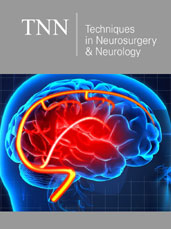- Submissions

Full Text
Techniques in Neurosurgery & Neurology
Surgical Anatomy of the Clivus
Behzad Saberi*
Medical Research, Iran
*Corresponding author:Behzad Saberi, MD, Medical Research, Esfahan, Iran
Submission: July 13, 2019;Published: August 22, 2019

ISSN 2637-7748
Volume2 Issue4
Mini Review
Clivus as an anatomical structure is located at the skull base center and due to its deep location, surgical access to it would be challenging. Petrous-clival line lesions are the main lesions which would extend to the clivus. Tumors of the clivus may be limited to it or be extended to foramen magnum and cervical spine, suprasellar region, sub temporal region, cavernous sinus and CP-Angle. There are various intradural or extradural lesions which can develop in the clivus and these can be chondrosarcomas, chondromas, adenocarcinomas, basal cell carcinomas, squamous cell cancers, osteogenic sarcomas as malignant lesions and glomus jugulare tumors, meningiomas, cholesterol granulomas and epidermoid cysts as benign lesions. Meningiomas and chondromas are the main lesions which involve clivus. The lesions of the clivus can involve and displace some anatomical structures like the abducens nerve, lowest seven cranial nerves, the basilar artery and the brainstem. Considering these matters, having the precise knowledge about the surgical anatomy of the clivus is crucial to approach the lesions of this area more accurately with lowest surgical complications and achieving the best surgical results.
The clivus extends from the dorsum sellae to the foramen magnum. The clivus formed by two anatomical parts: occipital part and sphenoidal part. The occipital part corresponds to the inferior two thirds while the sphenoidal part corresponds to the superior third. Presence of facial, sphenoid and petrous bones, basilar artery, temporal lobes, cavernous sinus, cranial nerves, petrous carotid arteries and brainstem around the clivus, makes its surgical access to be more complicated.
From the anatomical point of view, the clivus can be divided into two parts-superior and inferior-or into three parts-upper, middle and lower -. Above the abducens and trigeminal nerves crossing from the posterior to the middle cranial fossa, the upper clivus part is located. Sphenoid sinus, sella turcica, midbrain, basilar artery, cranial nerves III, IV, V, VI, cavernous sinus and temporal lobes are the upper part’s boundaries which include the posterior clinoid processes and dorsum sellae. Between the fifth and ninth cranial nerves exists, the middle clivus part is located. Cranial nerves VII and VIII, basilar artery, pons, upper nasopharynx, petrous apices and retropharyngeal tissues are the boundaries of this part. From the ninth cranial nerve to the foramen magnum, the lower clivus part is located. Cranial nerves IX, X, XI, XII, sigmoid sinus, medulla, vertebral artery, retropharyngeal tissues, jugular bulb and lower nasopharynx are the boundaries of this part. Internal auditory canal is the anatomical structure which separates the superior and inferior clivus parts.
There are three general approaches to reach clivus which are anterior, anterolateral and posterolateral ones. Extradural lesions with primary clivus involvement and extracranially extension needs anterior approaches like transcervical, transethmoidal, trans-sphenoidal, transmaxillary, transoral-transpalatal and subfrontal transbasal extra intradural approaches. Chondromas, pituitary tumors, chondrosarcomas, and craniopharyngiomas are the lesions which can be reached by these approaches. The subtemporal transtentorial and frontotemporal trans-sylvian approaches are the anterolateral approaches which mainly used for the upper and middle intradural clivus tumors with surrounding regions extension. The retro sigmoid, combined sub temporal suboccipital presigmoid with posterior petrosectomy and extreme lateral transchondylar approaches are the posterolateral approaches which are used to reach medial and lower parts of the clivus tumors which have extension to the foramen magnum, CP-Angle, upper cervical region and petrous bone [1-6].
References
- Al-Mefty O, Kadri PA, Hasan DM, Isolan GR, Pravdenkova S, et al. (2008) Anterior clivectomy: surgical technique and clinical applications. J Neurosurg 109(5): 783-793.
- Pallini R, Patel S, Salvinelli F (1996) Petroclival tumors. Anterolateral Approaches. In: Salvinelli F, De La Cruz A (Eds.), Otoneurosurgery and Lateral Skull Base Surgery. Philadelphia: Saunders, USA, pp. 457-472.
- Maira G, Pallini R, Anile C, Fernandez E, Salvinelli F, et al. (1996) Surgical treatment of clival chordomas: the transsphenoidal approach revisited. J Neurosurg 85(5): 784-792.
- Frank G, Sciarretta V, Calbucci F, Farneti G, Mazzatenta D, et al. (2006) The endoscopic transnasal transsphenoidal approach for the treatment of cranial base chordomas and chondrosarcomas. Neurosurgery 59(1 suppl 1): ONS50-ONS57.
- Vougioukas VI, Hubbe U, Schipper J, Spetzger U (2003) Navigated transoral approach to the cranial base and the craniocervical junction: technical note. Neurosurgery 52(1): 247-250.
- Van Havenbergh T, Carvalho G, Tatagiba M, Plets C, Samii M (2003) Natural history of petroclival meningiomas. Neurosurgery 52(1): 55-62.
© 2018 Behzad Saberi. This is an open access article distributed under the terms of the Creative Commons Attribution License , which permits unrestricted use, distribution, and build upon your work non-commercially.
 a Creative Commons Attribution 4.0 International License. Based on a work at www.crimsonpublishers.com.
Best viewed in
a Creative Commons Attribution 4.0 International License. Based on a work at www.crimsonpublishers.com.
Best viewed in 







.jpg)






























 Editorial Board Registrations
Editorial Board Registrations Submit your Article
Submit your Article Refer a Friend
Refer a Friend Advertise With Us
Advertise With Us
.jpg)






.jpg)














.bmp)
.jpg)
.png)
.jpg)










.jpg)






.png)

.png)



.png)






